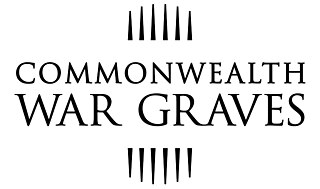
The Commonwealth War Graves Commission (CWGC) is an intergovernmental organisation of six independent member states whose principal function is to mark, record and maintain the graves and places of commemoration of Commonwealth of Nations military service members who died in the two World Wars. The commission is also responsible for commemorating Commonwealth civilians who died as a result of enemy action during the Second World War. The commission was founded by Sir Fabian Ware and constituted through Royal Charter in 1917 as the Imperial War Graves Commission. The change to the present name took place in 1960.
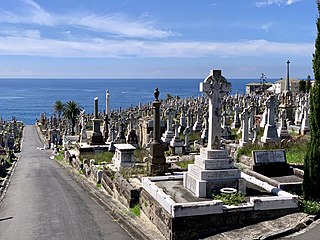
The Waverley Cemetery is a heritage-listed cemetery on top of the cliffs at Bronte in the eastern suburbs of Sydney, New South Wales, Australia. Opened in 1877 and built by R. Watkins and P. Beddie, the cemetery is noted for its largely intact Victorian and Edwardian monuments. It is regularly cited as being one of the most beautiful cemeteries in the world. The cemetery contains the graves of many significant Australians including the poet Henry Lawson. Also known as General Cemetery Waverley, it was added to the New South Wales State Heritage Register on 28 October 2016.

Warracknabeal is a wheatbelt town in the Australian state of Victoria. Situated on the banks of the Yarriambiack Creek, 330 km northwest of Melbourne, it is the business and services centre of the northern Wimmera and southern Mallee districts, and hosts local government offices of the Shire of Yarriambiack. At the 2011 census, Warracknabeal district had a population of 2,745, of which 2,340 lived in the town.

The Kranji War Cemetery is located in Kranji, Singapore, and is the final resting place for Allied soldiers who perished during the Battle of Singapore and the subsequent Japanese occupation of the island from 1942 to 1945 and in other parts of Southeast Asia during World War II.

The Melbourne General Cemetery is a large necropolis located 3 km (1.9 mi) north of the city of Melbourne in the suburb of Carlton North.

The Sydney Town Hall is a late 19th-century heritage-listed town hall building in the city of Sydney, the capital city of New South Wales, Australia, housing the chambers of the Lord Mayor of Sydney, council offices, and venues for meetings and functions. It is located at 483 George Street, in the Sydney central business district opposite the Queen Victoria Building and alongside St Andrew's Cathedral. Sited above the Town Hall station and between the city shopping and entertainment precincts, the steps of the Town Hall are a popular meeting place.

The Taiping War Cemetery is the final resting place for Allied personnel who were killed during World War II, particularly the Malayan Campaign and the Japanese occupation of Malaya following the British occupation and colonization of Malaya. Servicemen who died after the war or during their posting in northern Malaya prior to the Malayan Emergency are also interred here. The cemetery is located in Bukit Larut, Taiping, Perak, Malaysia and was erected and maintained by the Commonwealth War Graves Commission.
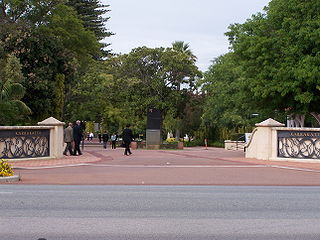
Karrakatta Cemetery is a metropolitan cemetery in the suburb of Karrakatta in Perth, Western Australia. Karrakatta Cemetery first opened for burials in 1899, the first being that of wheelwright Robert Creighton. Managed by the Metropolitan Cemeteries Board, the cemetery attracts more than one million visitors each year. Cypress trees located near the main entrance are a hallmark of Karrakatta Cemetery. The cemetery contains a crematorium, and in 1995 Western Australia's first mausoleum opened at the site.
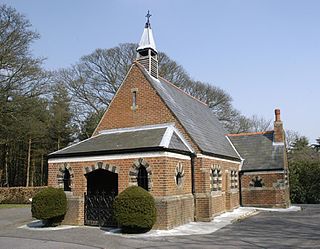
Aldershot Military Cemetery is a burial ground for military personnel, or ex-military personnel and their families, located in Aldershot Military Town, Hampshire.
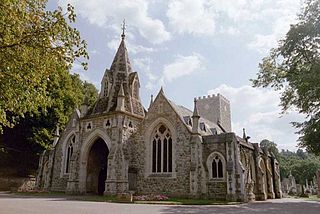
Putney Vale Cemetery and Crematorium in southwest London is located in Putney Vale, surrounded by Putney Heath and Wimbledon Common and Richmond Park. It is located within 47 acres (19 ha) of parkland. The cemetery was opened in 1891 and the crematorium in 1938. The cemetery was originally laid out on land which had belonged to Newlands Farm, which was established in the medieval period.

The West Terrace Cemetery is South Australia's oldest cemetery, first appearing on Colonel William Light's 1837 plan of Adelaide. The 27.6 hectares site is located in Park 23 of the Adelaide Park Lands just south-west of the Adelaide city centre, between West Terrace, Anzac Highway, Sir Donald Bradman Drive and the Seaford and Belair railway lines. Originally known as the Adelaide Public Cemetery, it is divided into a number of sections for various communities and faiths, including two Catholic areas, as well as Jewish, Afghan, Islamic and Quaker sections.

Brim is a small town in the Wimmera region of Victoria, Australia. The town is located 359 kilometres (223 mi) north west of the state capital, Melbourne on the Henty Highway. It is on the banks of the Yarriambiack Creek. It is in the Shire of Yarriambiack local government area. At the 2016 census, Brim had a population of 171.
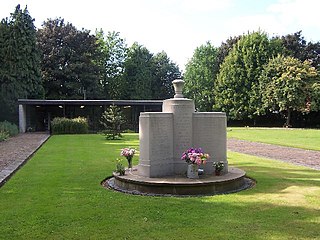
The South Stoneham municipal cemetery, situated off Mansbridge Road, Southampton, was opened in early 1905, with the first burial taking place on 4 February, and was extended in 1927. The South Stoneham Crematorium was located north of the cemetery but demolished during 1973 to make way for the construction of the M27 motorway. The South Stoneham garden of remembrance is now located at the north end of the cemetery.

Box Hill Cemetery is a cemetery located in Melbourne's eastern suburb of Box Hill, Victoria in Australia. It currently occupies 12.5 ha. It is known as the resting place of notable figures from Melbourne and its heritage-registered Columbarium and Myer Memorial. Around 50,000 decedents have been interred since the cemetery was gazetted and commenced operations in 1873. The original 10-acre site was extended in 1886 and again in 1935.
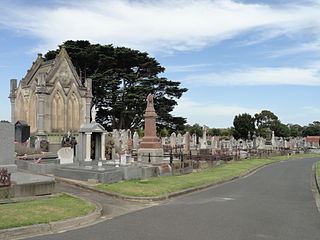
Brighton General Cemetery is located in the Melbourne suburb of Caulfield South, Victoria, but takes its name from Brighton, Victoria.

Rosebank Cemetery is a 19th-century cemetery in Edinburgh. It is located at the junction of Pilrig Street and Broughton Road in the Pilrig area, close to the historical boundary of Leith. The cemetery is protected as a category C listed building.

The English coastal city of Brighton and Hove, made up of the formerly separate Boroughs of Brighton and Hove in East Sussex, has a wide range of cemeteries throughout its urban area. Many were established in the mid-19th century, a time in which the Victorian "cult of death" encouraged extravagant, expensive memorials set in carefully cultivated landscapes which were even recommended as tourist attractions. Some of the largest, such as the Extra Mural Cemetery and the Brighton and Preston Cemetery, were set in particularly impressive natural landscapes. Brighton and Hove City Council, the local authority responsible for public services in the city, manages seven cemeteries, one of which also has the city's main crematorium. An eighth cemetery and a second crematorium are owned by a private company. Many cemeteries are full and no longer accept new burials. The council maintains administrative offices and a mortuary at the Woodvale Cemetery, and employs a coroner and support staff.
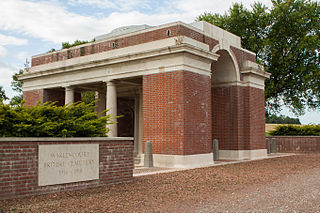
Warlencourt British Cemetery is a Commonwealth War Graves Commission burial ground for military personnel who died on the Western Front during the First World War. It is located in the Pas de Calais region of France. Established in 1919 to consolidate several smaller cemeteries, it was designed by Sir Edward Lutyens and is administered by the Commonwealth War Graves Commission. There are 3,450 soldiers interred, over which 1,823 are unidentified. There are also memorials to 55 soldiers whose graves are unknown. The majority of the soldiers who have been identified are British, with smaller numbers of Australians, South Africans, New Zealanders, and Canadians.

Tiverton Cemetery is the burial ground for the town of Tiverton in Devon. The cemetery covers eight acres and is owned and maintained by Mid Devon Council.

Zantvoorde British Cemetery is a Commonwealth War Graves Commission burial ground for the dead of the First World War located in the Ypres Salient in Belgium on the Western Front. It also contains the remains of a British airman killed during the Second World War.




















